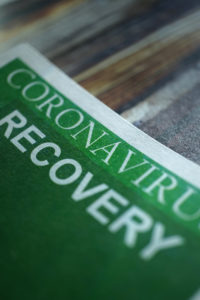October 15, 2020
By Thomas Aller, OD, FBCLA
Collaborator, BHVI

This was supposed to be the year of vision or optometry’s year, but 2020 ended up quite tragically as anything but. There were varying governmental responses to the COVID-19 pandemic worldwide, including shelter-in-place (SIP) orders, remote work, school at home, business closures, social distancing, and improved hygiene. Shortly after remote schooling was instituted, concerns were raised about the potential impact of increased usage of computers and other digital devices, along with a likely reduction in outdoor time, on the vision of children, and more particularly on the possible impact on myopia incidence and progression.1
Would there, in fact, be an epidemic of “covidopia” during this pandemic? These concerns were raised in a wide variety of consumer and professional media. These media offered sound advice about the need to take frequent breaks from intense near work and make sure that children get sufficient outdoor time during SIP, both for myopia concerns and dry eye. However, there have not been any data presented on the actual visual outcomes of children examined in clinical practice.
While there have been many studies over the years that show an association between near work and myopia2, years of schooling and myopia3, and near work behavior and myopia4, there have also been many studies that failed to show significant associations.5 Those who are convinced that excessive near work contributes to myopia incidence and progression and those convinced that insufficient outdoor time is a major lifestyle factor see good reasons for heightened concerns related to the changes brought about by the reactions to the COVID-19 pandemic.
There are press reports out of China suggesting an increase in myopia incidence among children during the pandemic period, suggesting that it was caused by a combination of online learning, increased digital device use both for educational use and play, and less outdoor time.6 The customarily recommended interval for eye examinations for children may be one year, but low adherence may result in longer intervals between exams. Myopic children or pre-myopic children not undergoing active myopia management treatments are not likely to have axial length measurements. They are also not likely to have three-month or six-month visits. So, it may be challenging to detect a change in myopia incidence or progression in a clinical population, or it may take some time before enough data can be collected.
My practice offers a wide variety of myopia management strategies and treatments for all young myopes, all progressing myopes, and young patients with the newly described pre-myopia.7 My practice is in the San Francisco Bay Area, a region and a state with some of the strictest, earliest, and longest-lasting SIP orders and regulations. All schools closed about three months prior to the end of term, and those closures, for the most part, have extended to the fall semester. There were restrictions governing travel, shopping, working, sports activities, and summer camps, and virtually any scheduled activities for children were eliminated. While the cannabis dispensaries were fully open to all, it was illegal to visit an optometry office, not to mention working at an optometry office. What prompted this article was the observation that the first 15 myopia-control patients returning to the office after optometry was declared an essential service averaged a slight reduction in myopia.
This initial case series was expanded to include the first 65 consecutive patients who satisfied the following criteria. They must have been managed for myopia progression with either bifocal glasses (including one Hoya MiyoSmart eyeglass user), atropine alone or in combination, multifocal soft contact lenses or orthokeratology, and they needed to have either refractive measurements and axial length measurements before and after the SIP, or in the case of orthokeratology, axial length measurements.
This cohort included 36 girls and 29 boys, predominately of Asian descent with 39 Asian, Pacific Islander or mixed, 12 Caucasian, 11 Indian, and three others. The average age of the patients at the “Pre-SIP” visit was 11.82 +/- 2.85 years, and the average interval between the “Pre-SIP” visit and the “Post-SIP” visit was 186.65 +/- 64.70 days. Table I shows the changes in myopia Pre and Post the SIP in terms of subjectively determined spherical equivalent refraction, averaged between two eyes. Axial lengths were measured with the Zeiss IOLMaster and were similarly compared before and after SIP and averaged between eyes. What is quite apparent is that there were exceedingly minimal changes in both refraction and axial lengths during this likely high myopia risk period. These low levels of myopia progression were found in the entire group and in each treatment category.
For comparison, expected emmetropic axial lengths (EAL) were calculated from the peer-reviewed literature8 for each patient for each visit, and expected changes over six months are shown in Table 1. Practitioners may use this converted formula in their spreadsheet: =IF(AGECELL#<10.5,20.189+(1.258*LN(AGECELL#)),IF(AGECELL#>10.49,21.353+(0.759*LN(AGECELL#)))) to calculate expected EAL and what might be considered normal axial growth.
Table 1. Refractive and Axial Length Changes Before and After SIP
| n | Pre-Rx | Post-Rx | Dur | Δ Rx | Δ AL | Δ EAL | |
| All Patients | 65 | -3.93 ± 2.30 | -3.99 ± 2.35 | 186 | -0.05 ± 0.35 | 0.09 ± 0.13 | 0.04 ± 0.02 |
| BF Specs | 6 | -3.16 ± 0.98 | -3.20 ± 0.99 | 155 | -0.04 ± 0.44 | 0.23 ± 0.20 | 0.06 ± 0.03 |
| MFCL | 39 | -4.20 ± 2.38 | -4.27 ± 2.43 | 208 | -0.07 ± 0.30 | 0.10 ± 0.11 | 0.04 ± 0.02 |
| OK | 18 | 156 | 0.01 ± 0.10 | 0.03 ± 0.01 |
Pre-Rx is the spherical equivalent manifest refraction averaged between two eyes for the examination closest to the beginning of the SIP. Post-Rx is recorded in the same way from the examination closest to the end of the SIP. Duration is the number of days between the two measurements. Δ Rx is the difference between these two measurements. Δ AL is the difference between Pre-SIP axial length and Post-SIP axial length from the composite axial length averaged between two eyes, derived from 20 measurements of each eye with the Zeiss IOLMaster 5.0. ΔEAL is the difference between the calculated emmetropic axial length for each child at the Pre-SIP visit and the Post-SIP visit.
There was an average of six months between measurements with the beginning of the SIP in the middle. The early part of this period included regular schooling and the winter season, factors that are known or suspected to encourage myopia progression.9 The later part of this period was dominated by SIP policies, remote learning, increased computer usage, increased smartphone use, decreased outdoor time, and no organized sports activities. These are among the factors cited in many warnings from various authorities and organizations that COVID-19 lifestyle changes may result in alarming increases in myopia in children. Given these known and suspected factors that might worsen myopia progression during this unique period in history, it may represent a somewhat unique period to analyze myopia control treatments’ effectiveness.
As these progression rates appeared to be relatively low, a further analysis was made for 45 of these patients who were previously treated for myopia progression, for whom refractive and/or axial data were available for the Pre-Pre-SIP period. For this overall group, myopia increased at a six-month rate of -0.15 ± 0.24D and axial lengths increased by 0.10 ± 0.09 mm. These rates were not statistically significantly different from the changes noted during the SIP.
These data merely indicate how myopia is progressing (or not) in one practice during a quite unusual moment in time. They do not show any increased risks of myopia progression during the SIP for children not being treated for myopia progression. Over the past 30 years parents have asked me if their children should reduce their reading times to help reduce myopia. My general advice has been that if we can find an effective treatment for their child, there should not be any reason to alter behavior. If it were easy to change human behavior to improve health, there would likely be much less need for medical treatment for hypertension, diabetes, and high cholesterol. Any myopia control treatment dependent on getting a myopic child to read less or use devices less is likely doomed to failure. I always encourage them to continue reading as much as they would like and/or as much as is required to excel at school, and I often ask their parents if they would prefer dumber kids? There have been zero parents saying that would be a great idea.
I would argue that the results from this case series showing very low myopia progression levels under active myopia management during what should have been a myopigenic storm would suggest that altering human behavior may not be a necessary component for myopia control. And at least for these myopia control patients, has COVID-19 led to “covidopia?” Rather, it has been “covidnopia.”

Thomas Aller, OD, FBCLA, is a fellow of the British Contact Lens Association and an associate member of the International Society of Contact Lens Specialists. He is the 2018 recipient of the Award of Excellence from the Global Specialty Lens Symposium and the 2019 recipient of the Garland Clay Award from the American Academy of Optometry.
- Wong CW, Tsai A, Jonas JB, et al. Digital Screen Time During COVID-19 Pandemic: Risk for a Further Myopia Boom? Am J Ophthalmol. 07 2020;doi:10.1016/j.ajo.2020.07.034
- Li SM, Li SY, Kang MT, et al. Near Work Related Parameters and Myopia in Chinese Children: the Anyang Childhood Eye Study. PLoS One. 2015;10(8):e0134514. doi:10.1371/journal.pone.0134514
- Nickels S, Hopf S, Pfeiffer N, Schuster AK. Myopia is associated with education: Results from NHANES 1999-2008. PLoS One. 2019;14(1):e0211196. doi:10.1371/journal.pone.0211196
- Harb E, Thorn F, Troilo D. Characteristics of accommodative behavior during sustained reading in emmetropes and myopes. Vision Res. Aug 2006;46(16):2581-92. doi:10.1016/j.visres.2006.02.006
- Lanca C, Saw SM. The association between digital screen time and myopia: A systematic review. Ophthalmic Physiol Opt. Mar 2020;40(2):216-229. doi:10.1111/opo.12657
- Cheng T. Ministry of Education: The myopia rate of primary and secondary school students increased by 11.7% in the first half of the year, with the fastest increase in primary schools. The Paper. Accessed 09/19/2020.
- Flitcroft DI, He M, Jonas JB, et al. IMI – Defining and Classifying Myopia: A Proposed Set of Standards for Clinical and Epidemiologic Studies. Invest Ophthalmol Vis Sci. 02 2019;60(3):M20-M30. doi:10.1167/iovs.18-25957
- Zadnik K, Mutti DO, Mitchell GL, Jones LA, Burr D, Moeschberger ML. Normal eye growth in emmetropic schoolchildren. Optom Vis Sci. Nov 2004;81(11):819-28. doi:10.1097/01.opx.0000145028.53923.67
- Donovan L, Sankaridurg P, Ho A, et al. Myopia progression in Chinese children is slower in summer than in winter. Optom Vis Sci. Aug 2012;89(8):1196-202. doi:10.1097/OPX.0b013e3182640996













